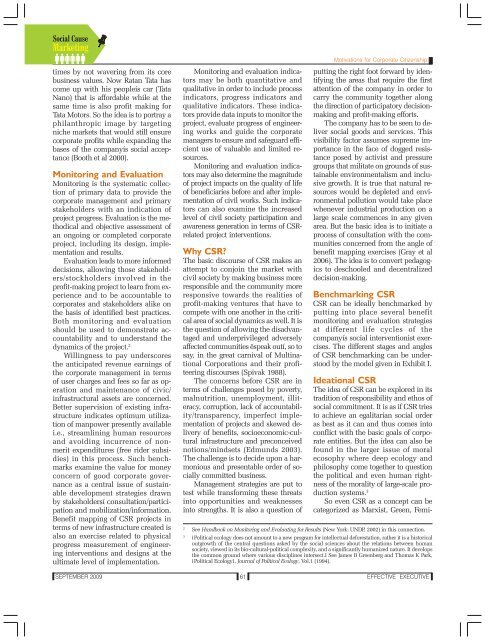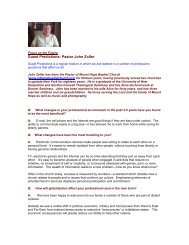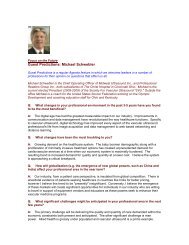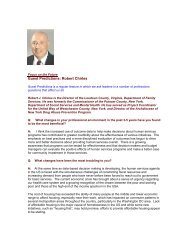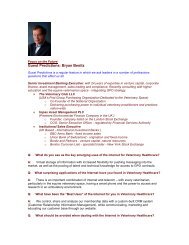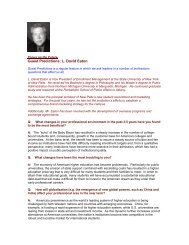Social Cause Marketing - The Regis Group Inc
Social Cause Marketing - The Regis Group Inc
Social Cause Marketing - The Regis Group Inc
You also want an ePaper? Increase the reach of your titles
YUMPU automatically turns print PDFs into web optimized ePapers that Google loves.
Motivations for Corporate Citizenship<br />
times by not wavering from its core<br />
business values. Now Ratan Tata has<br />
come up with his peopleís car (Tata<br />
Nano) that is affordable while at the<br />
same time is also profit making for<br />
Tata Motors. So the idea is to portray a<br />
philanthropic image by targeting<br />
niche markets that would still ensure<br />
corporate profits while expanding the<br />
bases of the companyís social acceptance<br />
(Booth et al 2000).<br />
Monitoring and Evaluation<br />
Monitoring is the systematic collection<br />
of primary data to provide the<br />
corporate management and primary<br />
stakeholders with an indication of<br />
project progress. Evaluation is the methodical<br />
and objective assessment of<br />
an ongoing or completed corporate<br />
project, including its design, implementation<br />
and results.<br />
Evaluation leads to more informed<br />
decisions, allowing those stakeholders/stockholders<br />
involved in the<br />
profit-making project to learn from experience<br />
and to be accountable to<br />
corporates and stakeholders alike on<br />
the basis of identified best practices.<br />
Both monitoring and evaluation<br />
should be used to demonstrate accountability<br />
and to understand the<br />
dynamics of the project. 2<br />
Willingness to pay underscores<br />
the anticipated revenue earnings of<br />
the corporate management in terms<br />
of user charges and fees so far as operation<br />
and maintenance of civic/<br />
infrastructural assets are concerned.<br />
Better supervision of existing infrastructure<br />
indicates optimum utilization<br />
of manpower presently available<br />
i.e., streamlining human resources<br />
and avoiding incurrence of nonmerit<br />
expenditures (free rider subsidies)<br />
in this process. Such benchmarks<br />
examine the value for money<br />
concern of good corporate governance<br />
as a central issue of sustainable<br />
development strategies drawn<br />
by stakeholdersí consultation/participation<br />
and mobilization/information.<br />
Benefit mapping of CSR projects in<br />
terms of new infrastructure created is<br />
also an exercise related to physical<br />
progress measurement of engineering<br />
interventions and designs at the<br />
ultimate level of implementation.<br />
Monitoring and evaluation indicators<br />
may be both quantitative and<br />
qualitative in order to include process<br />
indicators, progress indicators and<br />
qualitative indicators. <strong>The</strong>se indicators<br />
provide data inputs to monitor the<br />
project, evaluate progress of engineering<br />
works and guide the corporate<br />
managers to ensure and safeguard efficient<br />
use of valuable and limited resources.<br />
Monitoring and evaluation indicators<br />
may also determine the magnitude<br />
of project impacts on the quality of life<br />
of beneficiaries before and after implementation<br />
of civil works. Such indicators<br />
can also examine the increased<br />
level of civil society participation and<br />
awareness generation in terms of CSRrelated<br />
project interventions.<br />
Why CSR?<br />
<strong>The</strong> basic discourse of CSR makes an<br />
attempt to conjoin the market with<br />
civil society by making business more<br />
responsible and the community more<br />
responsive towards the realities of<br />
profit-making ventures that have to<br />
compete with one another in the critical<br />
area of social dynamics as well. It is<br />
the question of allowing the disadvantaged<br />
and underprivileged adversely<br />
affected communities ëspeak outí, so to<br />
say, in the great carnival of Multinational<br />
Corporations and their profiteering<br />
discourses (Spivak 1988).<br />
<strong>The</strong> concerns before CSR are in<br />
terms of challenges posed by poverty,<br />
malnutrition, unemployment, illiteracy,<br />
corruption, lack of accountability/transparency,<br />
imperfect implementation<br />
of projects and skewed delivery<br />
of benefits, socioeconomic-cultural<br />
infrastructure and preconceived<br />
notions/mindsets (Edmunds 2003).<br />
<strong>The</strong> challenge is to decide upon a harmonious<br />
and presentable order of socially<br />
committed business.<br />
Management strategies are put to<br />
test while transforming these threats<br />
into opportunities and weaknesses<br />
into strengths. It is also a question of<br />
putting the right foot forward by identifying<br />
the areas that require the first<br />
attention of the company in order to<br />
carry the community together along<br />
the direction of participatory decisionmaking<br />
and profit-making efforts.<br />
<strong>The</strong> company has to be seen to deliver<br />
social goods and services. This<br />
visibility factor assumes supreme importance<br />
in the face of dogged resistance<br />
posed by activist and pressure<br />
groups that militate on grounds of sustainable<br />
environmentalism and inclusive<br />
growth. It is true that natural resources<br />
would be depleted and environmental<br />
pollution would take place<br />
whenever industrial production on a<br />
large scale commences in any given<br />
area. But the basic idea is to initiate a<br />
process of consultation with the communities<br />
concerned from the angle of<br />
benefit mapping exercises (Gray et al<br />
2006). <strong>The</strong> idea is to convert pedagogics<br />
to deschooled and decentralized<br />
decision-making.<br />
Benchmarking CSR<br />
CSR can be ideally benchmarked by<br />
putting into place several benefit<br />
monitoring and evaluation strategies<br />
at different life cycles of the<br />
companyís social interventionist exercises.<br />
<strong>The</strong> different stages and angles<br />
of CSR benchmarking can be understood<br />
by the model given in Exhibit I.<br />
Ideational CSR<br />
<strong>The</strong> idea of CSR can be explored in its<br />
tradition of responsibility and ethos of<br />
social commitment. It is as if CSR tries<br />
to achieve an egalitarian social order<br />
as best as it can and thus comes into<br />
conflict with the basic goals of corporate<br />
entities. But the idea can also be<br />
found in the larger issue of moral<br />
ecosophy where deep ecology and<br />
philosophy come together to question<br />
the political and even human rightness<br />
of the morality of large-scale production<br />
systems. 3<br />
So even CSR as a concept can be<br />
categorized as Marxist, Green, Femi-<br />
2<br />
See Handbook on Monitoring and Evaluating for Results (New York: UNDP, 2002) in this connection.<br />
3<br />
ìPolitical ecology does not amount to a new program for intellectual deforestation, rather it is a historical<br />
outgrowth of the central questions asked by the social sciences about the relations between human<br />
society, viewed in its bio-cultural-political complexity, and a significantly humanized nature. It develops<br />
the common ground where various disciplines intersect.î See James B Greenberg and Thomas K Park,<br />
ìPolitical Ecologyî, Journal of Political Ecology, Vol.1 (1994).<br />
SEPTEMBER 2009<br />
61<br />
EFFECTIVE EXECUTIVE


